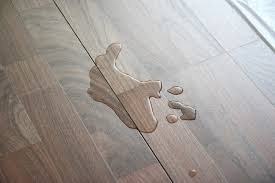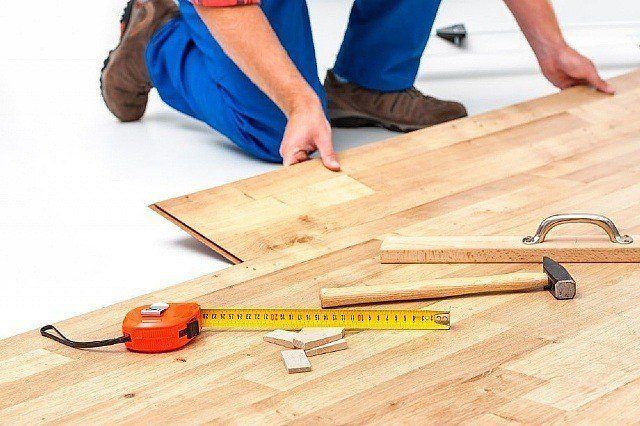This Is How To Clean Laminate Floors The Right Way
Laminate floors are a fantastic choice for any high-traffic home. Not only are they attractive, but they can stand up to the wear and tear that comes with having kids, pets, and a busy household. All that’s needed to keep them looking like new is regular cleaning.
Despite their durability, though, laminate floors don’t respond well to many of the cleaning techniques used on hardwood or vinyl. Harsh chemicals and abrasive scrubbers can damage the surface, and the buildup from wax or polish can leave your floors looking dull.
Want to learn how to clean laminate floors without doing any harm to them? Read on for a quick and easy guide to laminate floor care.
Laminate Floor Cleaning: What Not To Do
The first step in figuring out how to clean laminate hardwood floors is understanding how not to clean them. The composition of laminate flooring (a layer of compressed wood particles topped with a plastic veneer) makes it sensitive to heat and moisture.
Here are some common cleaning methods to steer clear of using on a laminate wood floor.
Avoid Water
The composite layer of laminate is made of wood particles packed tightly together and bound with adhesive. It absorbs moisture as much as (and sometimes more than) solid wood planks. The flooring expands when it soaks up water and can warp, bend, bubble, or even separate the seams between planks.
The top layer of laminate flooring is water-resistant. Even so, water can seep through the cracks between planks if it’s left to sit.
This means you should avoid cleaning laminate floors with large amounts of water like with a traditional wet mop. If water or another liquid does spill on the floor, wipe it up as soon as possible.
Avoid Heat
The top layer of laminate (called the “wear layer”) is made of a thin sheet of textured plastic. High heat can melt the plastic and disrupt the texture, cause the wear layer to peel off, or weaken the adhesive holding the composite layer together.
Because of this, you should avoid using a steam cleaner on laminate floors at all costs. The combination of heat and moisture can do permanent damage to the floor after only one cleaning.
Avoid Scratches And Buildup
While scratches won’t damage the integrity of your floor, they can dull the laminate’s natural shine. Avoid using these cleaning tools to prevent scratches and chips:
- Steel wool
- Stiff-bristled scrub brushes
- Woven plastic scrubbing pads
- Heavy vacuum cleaners, especially ones with a brush
- Abrasive cleaners
Along with scratches, floor waxes and polishes can also make your floor look dull when they build up over time. Try not to use oil- or ammonia-based cleaners made for hardwood floors. Soap can also leave a film behind, so use it sparingly and always remove the residue before it dries.

How to Clean Laminate Floors
Once installed, laminate must be properly cared for to keep it looking as good as day one. Read on for our tips for cleaning your laminate floors.
Laminate flooring is a popular feature in many homes. Once considered a basic, economical choice, laminate has become much better looking over the decades, and some options are nearly impossible to distinguish from real hardwood—making it a functional and stylish choice. Laminate flooring is also durable, so it’s great for homes with kids and pets. But once installed, laminate must be properly cared for to keep it looking as good as day one.
Sweeping and Vacuuming
The most important aspect of cleaning your laminate flooring is regular care, and the first step is to consult your manufacturer’s instructions.
Generally, though, weekly sweeping or vacuuming will not only keep your floors from looking dirty, but will reduce the need for harsher, deeper cleans down the line. One part of laminate flooring to be mindful of is its top (or “wear”) layer. Made of a plastic, it guards against dogs, shoes, furniture, and other potential sources of damage. Though very durable, it’s important to take certain precautions to protect this layer when cleaning your floors.
Always use your vacuum on the “hardwood” setting to prevent the beater brush from spinning, and always use the vacuum’s soft brush attachment. Never use steel wool or other abrasive materials on laminate flooring, as doing so will damage that top wear layer.
Mopping
Laminate floors are not waterproof, and excessive moisture can cause major damage. (Among other issues, too much water can weaken the floor’s adhesive, causing bubbling.)
That said, it’s perfectly safe to mop your floors if you do so with care. It’s best to use a slightly damp, not wet, microfiber laminate mop, but a regular mop wrung out as much as possible works, as does a spray mop. Wipe down the floors with a dry cloth after mopping to remove any excess water; never let liquid pool on your floors. For best results, use a cleaning solution specifically made for laminate floors or a DIY option.
While some may say it’s okay to occasionally steam clean your laminate floors, most experts agree that it’s a bad idea. Steam cleaning requires high heat and lots of moisture—two things that laminate flooring doesn’t like.
Spot Cleaning
Don’t worry if you spill on your laminate floors, just be sure to wipe up the mess right away. Paper towel, a microfiber wipe, or any other soft, absorbent cloth will work just fine (remember, you don’t want to use anything coarse or abrasive and risk scratching the surface).
For a tough stain, it’s ok to spot clean with a little bit of cleaning solution. Additionally, it’s safe to use acetone (nail polish remover) on laminate flooring, which is a good way to remove oily or colored stains, like ink, lipstick, or marker (this is especially useful for folks with kids who like to draw on everything; acetone should get out even the toughest marks).
Dab a small amount of acetone on the area, then wipe immediately with a damp paper towel or rag. Repeat until the stain is gone.

Clean Up Spills Quickly And Dry Your Floor Thoroughly After Mopping.
Remember, liquid and laminate don’t mix well. To wipe up surprise spills or dry the floor after a mopping session, use a clean, dry microfiber mop (it makes sense to keep a few on hand). Stains such as red wine or ink can be cleaned with a small amount of nail polish remover or rubbing alcohol, but test in an unobtrusive area first.
Take protective measures, like banning stilettos.
Place mats or small rugs under potentially leaky objects like houseplants and pet bowls and use adhesive felt pads on the undersides of furniture to protect the floors from scratches.
High heels can leave irrepairable pockmarks in laminate floors, so it’s smart to make a no-shoe policy for family members and guests. It also protects your floor from excess dirt and sand, which can damage it over time — not to mention the crazy-high amounts of bacteria one pair of shoes can acquire in a single day.
Cleaning Small Messes And Scuffs
After you sweep up any dry dirt or hair, most small messes can be cleaned up with a damp microfiber cloth. You can either use plain water or dilute some white vinegar or rubbing alcohol. Remember to avoid pouring liquid directly on the floor when cleaning.
For stubborn spots or areas of buildup, some people turn to glass cleaners like Windex. This method is helpful in a pinch, but use it sparingly and only in small areas. Spray the glass cleaner on a microfiber cloth and rub the floor clean, going with the grain whenever possible.
Drips of candle wax or chewing gum will scrape off easily with a credit card if you freeze them with an ice cube first. For shoe scuffs, try rubbing the area with a dry tennis ball before reaching for cleaning chemicals.
Cleaning The Entire Laminate Floor
The best way to clean an entire room with laminate flooring is to use a damp microfiber or spray mop such as a Swiffer. These pick up dirt and grime without leaving streaks or pools of water. When washing a reusable mop head, don’t use fabric softener, as this can leave residue behind the next time you clean the floor.

Easy to Care For
Maintaining laminate flooring is easy, you want to vacuum the flooring weekly using a soft brush attachment to prevent it from scratching the flooring and simply spray a mist of the recommended cleaner onto small sections of the flooring at a time and wipe using a Micro-fiber cloth mop or clean dry rag. Avoid the impulse to purchase floor cleaners you see on grocery store shelves as they may be generic products that can harm your particular floor’s finish or appearance.
Get the Grit Up
Use good bristle doormats at all entrances to trap small stones and dirt before it has a chance to get ground into the surface of the finish. If the floor is left unattended grit and dirt will become embedded into the worn unprotected surface of the flooring causing ugly dark areas within the floor. We also highly recommend using Chair Glides to protect your laminate flooring from being scratched by chairs and other furniture using them will also make it very easy to slide out heavy furniture for cleaning. Furniture manufacturers usually only provide cheap undersized casters on their furniture which can cause damage to your Laminate flooring. Although laminate flooring is extremely durable manufacturers do not warranty their flooring against indentations in the surface caused by anything being rolled or dragged over the surface. We would suggest replacing any hard plastic casters with wider rubber casters that will not indent or mar the laminates surface. Spiked/Stiletto heeled shoes can also indent the surface of the flooring.
Wipe Up Spills
Make sure to clean up liquid spills as soon as possible. Even with the super tight seams of today’s laminate flooring, standing liquid can seep into the seams of the panels causing delamination and/or cupping of the edges of the boards and discoloration of the flooring itself. Spills should be wiped up right away.
Never Ever
how to clean hardwood floorsNever Use: Water and/or Vinegar, Furniture Polish, Wax-Based products, Detergents, Bleach, Polishes, Oil Soaps, Abrasive products or Acidic materials to clean laminate flooring. These will leave a dull film on the surface of your floor which will be difficult to remove in the future. Never use any abrasive cleaners, steel wool or scouring powders when cleaning your laminate flooring. It is also recommended to never use any kind of mechanical steam cleaner as excessive heat and moisture can cause delamination or other damage to the finish.